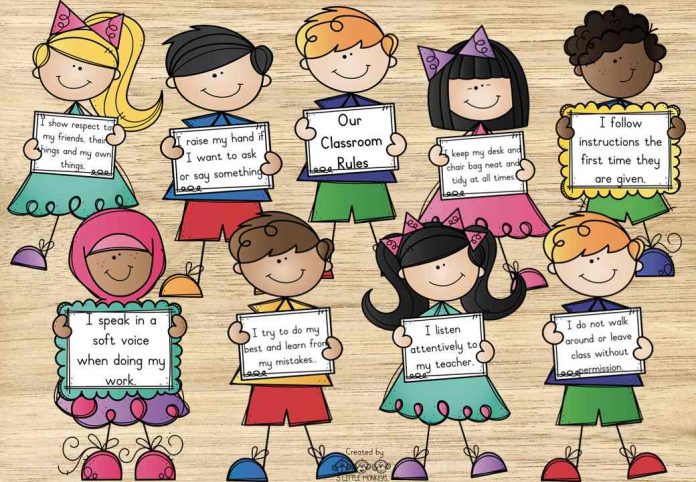- 1. Choose your keywords carefully
- 2. Make them clear and understandable
- 3. Communicate them to your students
- 4. Adjust them based on classroom feedback
- 5. Do not go overboard
- 6. Use effective discipline strategies
- 7. Do not use the same set of rules in every classroom
- 8. Make them easily accessible for students
- 9. Do not let the rules take over
- 10. Start at the beginning
Do your students struggle with following rules? Is it hard to make them understand that your class rules are non-negotiable? You’re not alone! Luckily, there’s a solution. With effective classroom rules, you can benefit both your students and yourself. Creating these rules can be tough, but we have the tips and tricks to make it easier.
Math & ELA | PreK To Grade 5
Kids see fun.
You see real learning outcomes.
Watch your kids fall in love with math & reading through our scientifically designed curriculum.
Parents, try for free Teachers, use for free
Why are Classroom Rules Important?

Well, there are many reasons why you should have classroom rules. Here are just a few:
1. Sets expectations and consequences
Establishing rules in your class will create an environment of respect where students know what to expect from you and vice versa. It creates boundaries and clarifies that the classroom is not a place for anarchy or chaos. You can limit rule-breakers by enforcing consequences as outlined in the rules.
2. Give students an overview of the class period
Everybody likes to be in control of their day. It is not only helpful for you but also for your students when they know what comes next. You can easily plan out a class period, considering all the activities you have prepared and how long each one will take. An overview of the period will help keep your students on track and increase their engagement in what is being taught.
3. Reduce behavior issues
Classroom rules are a great way to manage behavior issues in class. They put all students on the same page, so they know what is expected and can adjust accordingly. If there are consequences for not following the rules, students are less likely to act out in class.
4. Increase productivity
You will see your students more engaged when they know what is expected of them. They will not be wandering around or looking for directions on how to spend their study time. Having class rules makes it easier for you to manage your period efficiently and accomplish what you came in to do.
List of 30 Classroom Rules

Now that you know the benefits of having classroom rules let’s look at some of them. We have compiled a list of 30 basic classroom rules for your consideration. Let’s dive in!
1. Arrive on time for class.
2. Raise your hand to speak or volunteer.
3. Follow the dress code of the school.
4. Do not cheat or copy other people’s work.
5. Complete all assignments.
6. Listen to the teacher when being spoken to and answer the question.
7. Respect everyone in the class.
8. Keep your hands, feet, and objects to yourself.
9. Respect the school property.
10. Keep your language clean and appropriate for the classroom setting.
11. Do not leave your seat without permission.
12. Do not eat or drink in class (except for water).
13. Follow all classroom procedures and routines without reminders.
14. Ask for help if you do not understand something the teacher just said, and be respectful while asking for it.
15. Be on time for every assignment or test (except for medical or other emergencies).
16. Do your best work each day, regardless of how much time is left in class.
17. Maintain positive behavior towards classmates and teachers at all times.
18. Address any disruptive behavior immediately and respectfully.
19. Treat others how you want to be treated, with kindness and respect.
21. Refrain from interrupting the class during instruction or group activities.
22. Listen to what the teacher says and follow directions carefully.
23. Clean up your desk and dispose of trash properly after lunch.
24. Tell the truth!
25. Raise your hand if you have a question and wait to be called on.
26. No one should ever be made to feel bad about who they are.
27. Respect each other’s ideas and opinions even if you disagree with them.
28. Work quietly during independent study time to avoid disturbing others.
29. Follow the classroom seating arrangement and stay in your assigned seat unless instructed otherwise.
30. Report any issues or conflicts to the teacher immediately instead of trying to handle them on your own.
And there you have it, 30 classroom rules that are sure to keep your students engaged and productive in class! You may find that some of the rules apply only to specific subjects or grade levels. Feel free to modify the rules that do not apply in your classroom. Now let’s learn how to create your own set of rules that work best for you and your students.
Related Reading: Best Classroom Management Strategies for An Orderly Class
What’s the Best Approach to Create Class Rules?

Now that we’ve covered why class rules are essential let’s talk about how to create them. There is no one-size-fits-all approach; depending on your teaching style and what you want to accomplish in class, they can be either strict or flexible.
Rules that are too strict or not suitable for your class
There is such a thing as too strict. If you already have behavior issues in your classroom, no rule will help you unless you make significant changes to how your students perceive and understand the purpose of the common school rules. Depending on what kind of class this is, it can be challenging to have suitable rules for every student. Sometimes the number of pros does not outweigh the number of cons.
Rules that are too flexible or not respected by students
Having flexible class rules will make your students want to take advantage of them. And if you do not respect them yourself, they might not be very effective. It can create a hostile environment in your classroom when these general classroom rules are not taken seriously by you or your students.
Related Reading: Best Tips For a Student-Centered Learning Environment
How to Develop Classroom Rules That Promote Positive Expectations?

To establish classroom rules for students that work for everyone, it is best to know what kind of class this is and how strict you need them to be. Everyone adheres to different expectations, so do not force yourself into a specific model. If you do not want to have a rigid list of rules, that is perfectly fine. You can still have a positive class culture by being flexible with the guidelines and focusing more on students’ behavior rather than their actions.
Here are some simple steps you can take to get started:
1. Choose your keywords carefully
Before anything else, you need to decide what words you will use when talking about the rules. Your students need to know that these are not just guidelines but actual expectations they must abide by. You can refer to them as your “classroom guidelines” or “classroom policies.” Regardless of what words you choose, make sure that your students are aware of what these are.
2. Make them clear and understandable
The next step is to make them clear, especially if you are coming up with a list of more than one rule. Use words that are easy to understand so students do not get confused or misinterpret rules on their own. You can also create a presentation or handout with examples of the rules in specific situations so students know how to react.
3. Communicate them to your students
After setting up your list of rules, communicate them to your students clearly and often. Keep a copy of them where all of your students can see and post reminders around the classroom that they can refer to. Regarding class rules, repetition is vital to reinforce them with your students.
4. Adjust them based on classroom feedback
Based on their effectiveness, you will learn what works well in your classroom and what does not. Make changes to improve them along the way instead of waiting until the end of the semester or school year. You can also adapt or adjust them according to feedback from your students so they are more comfortable with them.
5. Do not go overboard
Having too many rules can have the opposite effect, so it is best to keep it simple. If you have trouble coming up with enough rules, focus more on behaviors instead of actions. For example, if a student does not follow nonverbal cues like raising their hand or staying quiet during class discussions, that is the behavior that needs to be addressed.
6. Use effective discipline strategies
Instead of worrying about your class rules, focus on how you will deal with breaking them. There are many ways to address poor behavior and discipline students accordingly, so do not get stuck on the number of rules you have for them in particular. They need to know that the rules are not there to make their lives more complicated but to help them succeed in class and beyond.
Related Reading: Ways to Implement Restorative Practices in the Classroom
7. Do not use the same set of rules in every classroom
Your students will notice if you are using exactly the same set of rules with other classes or teachers, so it is best to make them personal to your own teaching philosophy. You can always start with a list of rules from another teacher to use as a base, but make them your own by adding or removing certain ones along the way.
8. Make them easily accessible for students
Ensure they are easily accessible and available for your students so they can refer to them when necessary. Having physical copies in several places, like on the front or blackboard, at their desks, or in a binder will make them easily accessible.
9. Do not let the rules take over
Remember to keep things balanced by not letting the rules become too much of a focus for your students during class time. It is equally essential to provide positive praise when they are following through with necessary actions or behaving well.
10. Start at the beginning
Some teachers like to start with rules during the first few days of class, but others prefer to wait until later on when their students are more comfortable with things. You can even use them right away if you know your students will be different and need an adjustment period. It all depends on how well they work for your specific students.
11. Make them age-appropriate
Think about what sort of rules will be the most helpful for your class and their needs. They should be age-appropriate, so if you are teaching elementary school students, then using complex phrases or words that might go over their heads is not recommended. When in doubt, picking ones that are familiar to them, like “raise your hand before speaking” or “come to class prepared for lecture,” will be helpful.
How To Uphold Classroom Rules?
Many teachers wonder how exactly they should keep their students in line when it comes to following classroom rules, so here are some effective methods.
1. Give consequences
When students violate the classroom rules, you should address them by giving them a consequence appropriate for their actions. If they did not follow one of your classroom discipline rules, just explain why and what the rule is in general so they understand it better.
2. Use positive reinforcement to reward good behavior
Teachers who use positive reinforcement with their students find that the students do not need as many consequences because they are already doing well! Make sure to compliment good behavior when you see it or hear about it, but avoid saying negative things about bad behavior since that might make them think acting out is okay.
You can even give tokens throughout the day to those who behave well, which will turn into credits at the end and can be used for special privileges like a student of the day, going to recess early, or choosing their own seat.
3. Track class performance
The key to being effective with classroom rules is to have a system that works for you and your students, so be sure to track their performance during the school year. You can use SplashLearn to get insights into how your students are performing as a whole as well as individual students so you can understand where they need the most work.
4. Be consistent with consequences and rewards
It is imperative that you are consistent with enforcing your rules and rewarding good behavior if you want them both to work well within your students’ lives at school! Ensure that you follow through with all punishments and rewards that you set forth, or else they will not encourage compliance.
5. Keep things positive
From day one, it is important to maintain a positive classroom environment where your students feel safe and comfortable so they do not want to act out as much as possible. Once you have established this type of classroom, you will see that most problems can be solved without needing consequences because they will be minimal in the first place.
6. Be patient
Remember that it takes a lot of time and patience to get through this process, so do not get frustrated if there are still problems from time to time. Talk with your students about the rules before starting class, and have them help you develop ways for problem-solving. By keeping the lines of communication open, you will be able to resolve issues as they happen, so you do not need to punish anyone.
7. Involve parents in reinforcing classroom rules
Collaborate with parents to reinforce classroom rules at home. Regular communication with parents about their child’s behavior and progress helps create a consistent environment between school and home. This involvement ensures that students understand the importance of following rules and encourages positive behavior both in and out of the classroom.
8. Be prepared for emergencies
Unfortunately, even the best classroom rules and students can lead to accidents. Because of this, you must have a plan for how your class will handle emergencies before they happen so you are ready if anything happens. The more prepared you are ahead of time, the more effective you will be during an emergency.
Conclusion
The list of classroom rules can be endless, but here are 30 basic ones to help you start or refine your own. From simple rules like “raise your hand before speaking” to complex concepts like teaching students how their brains work, these principles can lead to higher success in school.
Though it may seem daunting, applying these rules often results in less stress for teachers. If you have any additional rules, let us know, and we might add them to the list!
Related Reading: Best Classroom Management Tools
Frequently Asked Questions (FAQs)
How can you make rules meaningful to the students?
Kids are easy to please, and science proves it! So many factors come into play when making rules meaningful to students. We suggest that you allow the students to have a part in making the rules.
When that happens, everyone feels as if they have a stake in what is happening and that things are fair for all. In addition, they will feel as if their opinion is heard and valued by you as an educator.
How do I make sure students trust what I say?
Teachers must have credibility within their classrooms. If you are the teacher, then it is your goal to gain your students’ trust so that they listen to you when you need them to. There are several ways for you to do this. First, create a classroom culture where your students know that what you say goes and will be enforced.
Second, never say something that you don’t mean. If you do, your students will quickly learn to ignore you when needed. Lastly, make sure to follow through with the consequences you make known ahead of time!
How many classroom rules should you have?
We all know that too many cooks in the kitchen spoil the broth. The same is true when it comes to classroom rules. Teachers who can get their student’s attention quickly without saying too much usually have fewer rules. However, this might not fit every type of level or age of the student. In addition, teachers should consider what their school expects from them regarding rules. In the end, no one can say for sure how many rules you should have in your classroom. It is best to consider all of the above and then create a list that works for you!
What is the most important rule to have in the classroom?
That all depends on what you are trying to accomplish as a teacher. For example, some teachers might say that their most important rule is “raise your hand before speaking.” In our opinion, this would be beneficial for students who have trouble staying focused or might not know when it is their turn to speak in class. If you are working with students who have trouble keeping their focus, that might be one of your most important rules.
What are the 5 P's classroom rules?
The 5 P’s classroom rules are: Be Prompt, Be Prepared, Be Polite, Be Productive, and Be Positive. These guidelines help maintain a respectful and efficient learning environment.
























